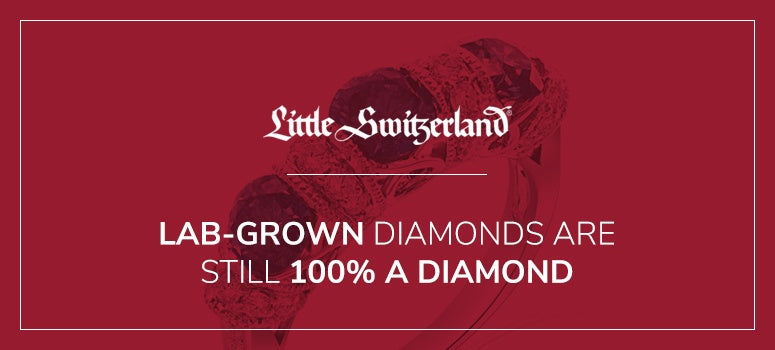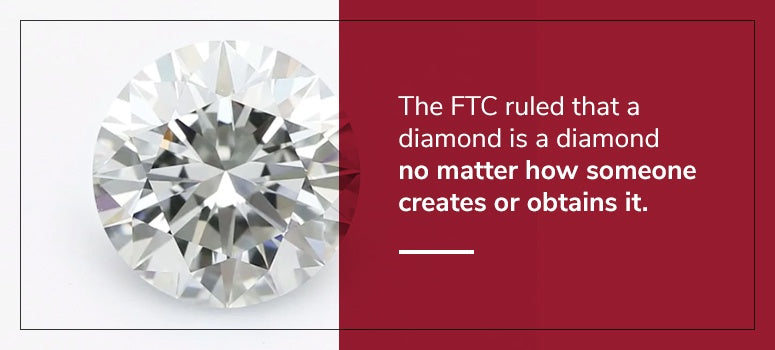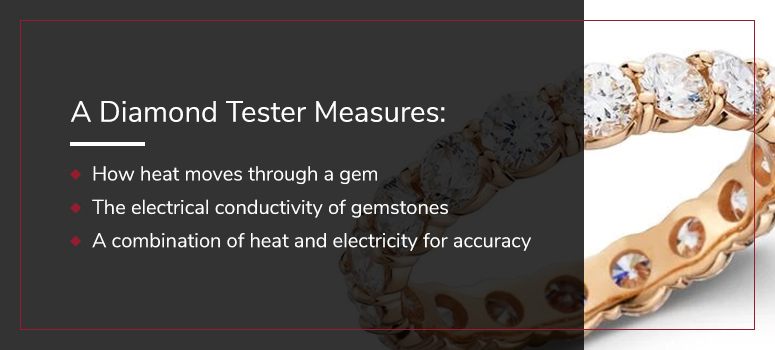Lab-Grown Diamonds Are Still 100% a Diamond

While searching for diamond jewelry, you may have come across lab-grown diamonds. Don't let the name deter you. Lab-grown diamonds are still 100% a diamond, but we get them through different methods than below ground diamonds.
Scientists create diamonds under controlled conditions in a lab, and lab-grown diamonds require no mining or demanding physical labor like below ground gems do. Shop with confidence knowing that lab-grown stones are authentic diamonds. They also look as brilliant — if not more so — than mined varieties.
Are Lab-Grown Diamonds Real?
Manufactured, cultured or engineered — no matter what you call lab-grown diamonds, they are authentic. Still, confusion is understandable. White lab-grown diamonds didn't hit the jewelry industry until the 21st century, making them a new concept. When they came into the market, restrictions on their terminology confused customers. Manufacturers had to label lab-grown diamonds with words that made buyers question their authenticity. Recently, those requirements have changed.

The U.S. Federal Trade Commission (FTC) updated its Jewelry Guides in 2018. The amendments include specifics about lab-grown diamonds that clarify their authenticity. Among those amendments are:
- Necessary words to proceed lab-grown diamonds: Diamond manufacturers must still use "lab-grown" and "lab-created" to describe their gems. However, you may have also heard the term "synthetic diamonds." What are synthetic diamonds? The simple answer is they do not exist. "Synthetic" is no longer a required word for engineered diamonds. The FTC determined the term "synthetic" to be scientifically inaccurate. Because diamonds contain pure carbon and you cannot create an element, saying "synthetic diamonds" implied the lab somehow synthesized carbon. Omitting the term now clears up confusion about the authenticity of cultured diamonds.
- Acknowledgment that a lab-grown diamond is a diamond: The FTC ruled that a diamond is a diamond no matter how someone creates or obtains it. This acknowledgment is perhaps the biggest takeaway of the FTC's ruling. Even if a scientist creates the gem, it still consists of pure carbon and is authentic. How we get these gems does not determine whether or not they are a diamond. Researchers and jewelers depend on the composition of the material since that is what determines a diamond.
- A changed definition of diamonds: Previously, a diamond was defined as a "natural mineral." The FTC has removed the word "natural" since it implies diamonds can only come from mining the Earth. Natural diamonds still exist, of course, but the new definition allows room for lab-grown diamonds. Diamonds are now "minerals" that can come from man-made or natural methods.
- Simulants can no longer use the diamond label: Simulants, such as cubic zirconia, can no longer be labeled "synthetic diamonds." This amendment clarifies to buyers what is and isn't an authentic diamond. Because manufacturers labeled both simulants and lab-grown diamonds as "synthetic" in the past, buyers thought they were the same. Now you can shop with confidence and know whether you're admiring a lab-grown diamond or a simulant.
- Lab-grown diamonds are gemstones: Before the FTC's amendments, manufacturers could not refer to cultured diamonds as "stones," "real," "genuine" or "birthstones." Now, jewelers can acknowledge that man-made diamonds are real gemstones. The lab-grown variety of genuine diamonds is now also associated with being a birthstone, clearing up some confusion for buyers.
- Lab-grown diamonds are cultured: In the past, manufacturers could not refer to engineered diamonds as "cultured diamonds." The mined diamond industry did not want lab-grown gems to have an association with cultured pearls — but consumers understand cultured pearls, and they continue to purchase them knowing that they come from a man-made process. Allowing manufacturers to call lab-grown diamonds "cultured diamonds" allows buyers to compare their process to cultured pearls.
The FTC's ruling brings customers closer to understanding that lab-grown diamonds are real diamonds. Miners don't need to retrieve gems from the Earth for them to be authentic diamonds. Now, scientists can engineer real diamonds that are as stunning as mined varieties.
Lab-Grown Diamonds Are Real and Look Spectacular
When compared by the naked eye, lab-grown and mined diamonds look the same. The two varieties look alike because physically and chemically, they are identical. Their physical and chemical traits include the same:
- Components: Lab-grown and mined diamonds both consist of pure carbon. The pure elemental composition is why the FTC ruled lab-grown diamonds are not synthetic. Even colorful diamonds, whether mined or lab-grown, share the same components. Colored options from either source include additional elements that affect the diamond's hue.
- Properties: Chemical and physical properties show that mined and lab-grown diamonds are the same. These properties include light dispersion, refractive index, electron density and Mohs hardness rating. For the consumer, these properties mean a lab-grown diamond shines as bright as a mined one. A lab-grown diamond is also as hard as a mined diamond.
- Treatment: Scientists cut and polish lab-grown diamonds the same way they do mined varieties. Since they are treated the same way, these varieties of diamonds look the same as well. The fact that experts can cut, polish and repair lab-grown and mined diamonds with identical methods shows that the gems are the same. Different varieties of gems would require different methods of treatment.

It is nearly impossible to distinguish a cultured diamond from a natural one unless you examine them with specialized equipment. If you were to take a closer look, you might discover that lab-grown diamonds contain fewer inclusions than a mined diamond. Inclusions are minor imperfections you can't see with the naked eye, but the more a diamond has, the less brilliant it will appear. Since scientists create lab-grown diamonds under controlled conditions, they can limit the inclusions a gem has. Fewer inclusions contribute to a more dazzling gemstone. If you select a cultured diamond over a mined one, you'll find a brighter option at an affordable price.
Because the process for engineering a diamond is cheaper and requires less work than mining one, lab-grown diamonds cost less. Lab-grown diamonds are still a luxury item like mined gems, but you can save more with the engineered option. The average price per carat of a natural diamond is $5,000, while lab-grown is about $3,500. With the money you'd save, you could choose to buy a higher-quality lab-grown diamond or even a larger stone.
As manufacturers continue creating diamonds, their processes become more advanced. When scientist began engineering diamonds in the 1950s, the results were small, brown diamonds that were not jewelry quality. Instead, they were better for use in machinery or for cutting. It was not until the 1970s and 1980s that technology allowed for gem-quality products, but these lab-grown diamonds were only available in colored varieties due to impurities. scientists only achieved lab-grown white diamonds within the 21st century. Their process is always improving, though, and soon, labs will be able to produce even more substantial and brilliant diamonds.
Lab-Grown Diamonds Are All Different and Unique

You may imagine the production process creating diamonds in molds, stamping out the same gem over and over, but that is not the case. Manufacturers can engineer diamonds in two ways:
- High-pressure high-temperature (HPHT): This process mimics conditions within the Earth that produce natural diamonds. A mechanical press subjects a carbon source to high temperature and pressure until a diamond seed forms. HPHT is a fast process compared to the other method, and it can produce a more pure white diamond.
- Chemical vapor deposition (CVD): Scientists heat different gasses in a vacuum until carbon settles out and falls to a diamond seed, which often comes from the HPHT process. Carbon builds layers upon layers until a diamond forms. Manufacturers use CVD to create bridal stones or other larger diamonds. The CVD process creates diamonds with fewer impurities, and the gems have a high clarity.
Like natural mining, lab production creates unique results. No two lab-grown diamonds are the same due to their crystal structure. If anything, the manufacturing process creates gems that are more unique even than natural processes. That's possible in a few ways:
- Customized orders: Some diamond manufacturers offer custom orders. You can specify the size and shape you'd like, knowing the result will be a brilliant diamond in the perfect size for you.
- An array of colors: Mined colored diamonds are a rare find, meaning they are expensive. With lab-grown diamonds, it's easier for manufacturers to add the elements required to create those colors. Your diamond jewelry will look unique if you select colorful lab-grown diamond options.
- Purer composition: It is possible to create diamonds with undetectable impurities. The Gemological Institute of America (GIA) labels these diamonds type IIa. Only an estimated two percent of natural diamonds meet this purity standard. Manufacturers using the CVD method can frequently produce this grade of diamond. If you'd like a diamond so pure it's rare to find in nature, a lab-grown diamond is the best option.
Cultured diamonds have more variety than their natural counterparts, too. When you shop lab-grown options, you can find colorful diamond jewelry for any occasion or big and brilliant engagement rings. With natural mined options, what the Earth produces and what miners discover limit your selection. Jewelers often cut and polish these mined gems in certain ways, so you'd have to shop around to find your preferred style. No matter what option you choose, you will receive a certificate that guarantees your diamond is real.
Do Lab-Grown Diamonds Get Certificates of Authenticity?

When you buy a diamond, you should receive a certificate of authenticity. Many jewelers offer certificates of authenticity for mined and engineered diamonds alike. The certificate shows that your gem is a real diamond, not a simulant. It also provides different information about your gem. Among the information researchers provide in the certificate report are the popular four Cs. While many associate the four Cs with natural mined diamonds, GIA evaluates the same four well-known traits of lab-grown diamonds:
- Cut
- Clarity
- Color
- Carat
To get a certificate of authenticity and to determine the traits above, mined and manufactured diamonds go through a rigorous grading process. The process includes:
- Studies by independent labs: The labs have no association with members of the diamond industry. No diamond mines, dealers or retailers have involvement in the certification process to help guarantee unbiased research.
- Separate examinations: Several different researchers examine each diamond. By double- and triple-checking their results, they ensure consistency in the final grading. Multiple examinations create more accurate measurements in the final certificate.
- Highly-sensitive instruments: Grading labs use modern technology to examine diamonds. The sensitive equipment can detect any imperfections in the diamond. Along with the highly-trained researchers who use it, the equipment provides accurate measurements of the diamond's qualities.
Researchers report their findings in the certificate of authenticity that jewelers give to the customer. Customers should get these reports with either mined or engineered diamonds since they go through the same grading process. With the same composition and the same benchmark testing, it's clear to see — cultured and natural diamonds are the same. Since the only differences between manufactured and mined diamonds are their price, and how they're obtained, lab-grown gems tend to be the better option all around.
Will Lab-Made Diamonds Pass a Diamond Tester?
Since engineered diamonds pass authentication from labs, they will also pass a diamond tester. A diamond tester checks the authenticity of the gem to determine whether it is a real diamond or a simulant. A jeweler uses a tester when buying or exchanging jewelry from customers, repairing it or evaluating it. You can also purchase your own diamond tester if you have a large collection or you want to ensure the authenticity of your diamonds.

A diamond tester uses the varying properties of different gems to determine what is and is not a diamond. The tester uses a needle placed on the gem to measure either:
- How heat moves through a gem
- The electrical conductivity of gemstones
- A combination of heat and electricity for accuracy
Some testers also feature a metal detector which alerts users if they are touching the setting rather than the gem. Heat may move through your metal the same way it would through a diamond, so touching the tester to metal by mistake could produce a false reading.
Diamond testers are accurate, but heat-measuring ones may mistake moissanite for a diamond. The simulant and the authentic diamond conduct heat in similar ways, giving a false reading. Measuring electrical conductivity by itself or with heat movement eliminates this problem.
When it comes to comparing lab-made diamonds with mined ones, a genuine engineered diamond will pass a tester. Because the physical components of lab-made and mined diamonds are the same, they will have the same results on a diamond tester.
Shop Little Switzerland for Lab-Grown Diamonds
If you're ready to explore your authentic diamond options, shop at Little Switzerland. We carry a dazzling array of lab-grown diamond jewelry with out newest brand Engrace Diamonds by Little Switzerland. From rings, earrings, necklaces, and bracelets, find your favorite varieties with manufactured diamonds. Expand your jewelry collection with gems that are better for the environment and conflict-free.
Contact us today with any questions about our assortment of lab-grown diamonds. Browse our stunning collection when you're ready to expand your own. We at Little Switzerland are glad to help you select brilliant diamond jewelry that will last a lifetime.


